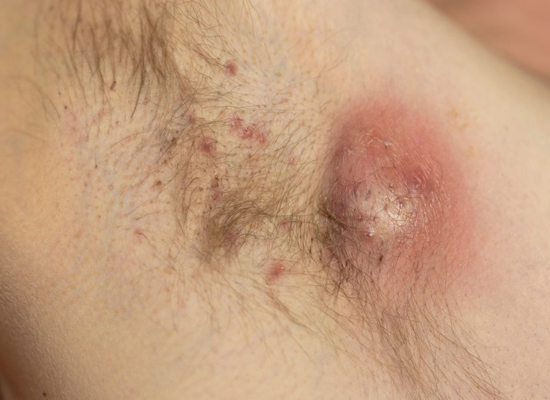
Hidradenitis suppurativa (HS) is a chronic, painful, and often misunderstood inflammatory skin condition that affects millions of people worldwide. Despite being as common as psoriasis, many individuals suffer for years before receiving a proper diagnosis. HS is marked by painful cysts, boils, scarring, and draining sores that commonly appear in areas where skin rubs together such as underarms, groin, buttocks, or beneath the breasts.
While the exact cause remains unknown, hidradenitis suppurativa is believed to stem from hair follicle blockages that rupture and become inflamed. Over time, these inflamed nodules can lead to sinus tracts which are tunnel-like structures under the skin that may leak pus, cause significant scarring, and emit unpleasant odors. These symptoms can greatly affect a person’s quality of life, both physically and emotionally.
If you’re dealing with recurrent boils or painful skin bumps, it’s important to know: HS is not caused by poor hygiene. It’s a complex medical condition involving genetics, hormones, and immune system dysfunction, and there are effective treatments that can help!
What Is Hidradenitis Suppurativa (HS)?
HS is a chronic, non-contagious skin disease that causes deep, painful bumps under the skin. These bumps often start as small, pea-sized lumps but can grow, burst, or tunnel under the skin, leading to drainage and lasting scarring.
The condition typically starts after puberty and can progress over time if left untreated. HS commonly affects:
- Armpits (Axillary)
- Inner thighs (Inguinal)
- Groin area (Genital)
- Buttocks (Gluteal)
- Under the breasts (Inframammary)
- Around the anus (Perineal)
- Under belly folds (Infrapannus)
Some patients describe the pain as throbbing, stinging, or pressure-like. The emotional toll can be just as significant, with many patients struggling with embarrassment, isolation, and even depression due to the visibility, odor, or unpredictability of flare-ups.
What Causes Hidradenitis Suppurativa (HS)?
The exact cause of hidradenitis suppurativa is still unclear, but it’s thought to be the result of multiple contributing factors. The condition begins when hair follicles become blocked, triggering inflammation. This can lead to nodules, abscesses, and sinus tracts that may eventually rupture and drain.
Key Contributing Factors:
- Genetics: HS often runs in families, and approximately 1/3 of patients with HS report a family history of the disease, suggesting a genetic predisposition
- Hormones: Many patients experience flares around their menstrual cycle or during times of hormonal change
- Immune System Dysfunction: Inflammation plays a central role in how the disease behaves
- Environmental Triggers: Heat, sweat, friction, and smoking can all worsen symptoms
It is important to emphasize that HS is not an infection and not caused by poor hygiene, a harmful misconception that has historically led to stigma and delayed diagnoses.
Who Gets Hidradenitis Suppurativa (HS)?
HS can affect anyone, but certain groups are at higher risk:
- More common in women than men
- Most often develops between the ages of 18 and 40
- Individuals with a family history of HS
- People with metabolic syndrome, obesity, or polycystic ovary syndrome (PCOS)
- Smokers (smoking is a known trigger and exacerbating factor)
Early diagnosis and intervention can significantly improve outcomes and slow disease progression.
What Are the Symptoms of Hidradenitis Suppurativa (HS)?
HS presents with a wide range of symptoms that can vary in severity. The condition often begins subtly and progresses over time.
Common Symptoms:
- Painful, red bumps or lumps under the skin
- Boil-like nodules that may rupture and leak fluid or pus
- Recurrent abscesses in the same areas
- Sinus tracts or tunnels forming under the skin
- Unpleasant odors from draining wounds
- Scar tissue or thickened areas of skin over time
Symptoms usually occur in skin folds or areas with frequent friction and moisture. These lesions can cause significant pain, discomfort, and embarrassment, especially if they interfere with movement or personal relationships.
Hurley Staging System for Hidradenitis Suppurativa (HS)?
The Hurley staging system is used to classify the severity of hidradenitis suppurativa:
Hurley Stage 1
- Single or multiple painful bumps
- No sinus tracts or scarring
- Mild and intermittent flares
Hurley Stage 2
- Recurrent nodules in multiple areas
- Formation of sinus tracts and scarring
- More persistent symptoms
Hurley Stage 3
- Extensive scarring and tunnel systems
- Involves large areas of the body
- Constantly persistent symptoms and pain
Treatment Options for Hidradenitis Suppurativa (HS)
While there is currently no cure for HS, the condition can be managed effectively with a combination of therapies. Treatment is based on the severity of your symptoms and may evolve over time as the disease progresses.
Conservative Measures
- Warm compresses to ease pain and swelling
- Loose clothing to reduce friction
- Weight management and smoking cessation (both can reduce flare frequency)
- Benzoyl peroxide cleanser
Medications
- Topical resorcinol for mild cases
- Topical antibiotics for mild cases (e.g. clindamycin, erythromycin)
- Oral antibiotics in anti-inflammatory doses (e.g. doxycycline, clindamycin, rifampicin)
- Oral anti-neutrophilic drug, Dapsone, for mild-to-moderate cases
- Corticosteroid injections into active lesions (e.g. triamcinolone)
- Oral retinoids such as isotretinoin (Accutane) or acitretin (Soriatane)
- Hormonal therapy: combination birth control pills (estrogen/progesterone) or cyproterone acetate for women only, or spironolactone for women or men
- Immunosuppressants: such as azathioprione, mycophenolate mofetil, or cyclosporine in moderate cases
Biologics
Biologic medications are FDA-approved for moderate to severe HS. These drugs target the inflammatory pathways involved in HS and has been life-changing for many patients.
- Adalimumab (Humira): TNF-2 inhibitor FDA-approved for moterate-to-severe HS
- Anakrina IL-1 Receptor Agonist: not FDA-approved from HS, but has been shown in some small pilot studies to be effective at suppressing the disease
- Infliximab (Remicade): TNF-alpha inhibitor not FDA-approved for HS, but was more potent than adalimumab (Humira) in some trials
- Secukinumab (Cosentyx): IL-12 and IL-23 receptor agonist FDA-approved for moderate-to-severe HS
Laser and Light Treatments
- Laser hair removal to prevent hair follicle occlusion
- Photodynamic therapy (PDT) to decrease bacterial load and shrink sebaceous glands
Surgical Treatment
- Incision and drainage of abscesses to provide temporary relief
- Punch debridement of newly inflamed nodules (early lesions)
- Wide excision surgery for persistent or severe disease, which provides permanent relief but is very invasive
- Unroofing and debridement of individual sinus tracts, providing temporary relief, but does not prevent future disease
- Skin grafting in cases of large excised areas
Living with Hidradenitis Suppurativa (HS): Emotional Support & Lifestyle Tips
Dealing with HS is about more than just treating skin symptoms, it’s also about caring for your mental health and adjusting daily habits to reduce flare-ups.
Tips for Managing HS:
- Use cleansers containing benzoyl peroxide in the affected areas
- Avoid shaving affected areas; consider laser hair removal instead
- Wear loose, breathable clothing
- Manage stress with mindfulness and/or counseling
- Keep a flare diary to track triggers and response to treatments
- Exercise and maintain a healthy body weight (this is critical)
- Smoking cessation can reduce flares in smokers
Emerging Therapies
- Metformin
- HS is strongly linked with metabolic-syndrome traits. By improving peripheral insulin sensitivity and down-regulating the insulin–IGF-1/mTOR axis, metformin can dampen the pro-inflammatory, hyper-keratinizing signals that contribute to follicular occlusion.
- Lowering hepatic glucose output reduces circulating insulin and, secondarily, free-androgen levels, helpful in HS patients with PCOS-like features
- AMPK (activated protein kinase) activation shifts macrophages and keratinocytes toward an anti-inflammatory phenotype and limits neutrophil extracellular-trap formation seen in HS tunnels
- Zinc
- Oral zinc inhibits neutrophil chemotaxis, down-regulates TNF-alpha and IL-6, and normalizes integrin expression in keratinocytes, lowering tunnel-wall inflammation
- Zinc directly blocks type I & II 5-alpha-reductase in human skin, decreasing local DHT (testosterone) and the androgen-driven follicular occlusion seen in HS
- As a trace element for superoxide-dismutase and collagen cross-linking, zinc limits oxidative damage and supports re-epithelialization of chronic tunnels
- HS cohorts show lower mean serum zinc; repletion may address a contributing nutrient deficiency
Don’t be afraid to talk to your dermatologist about the emotional toll of HS. Support groups, online forums, and counseling services can offer a sense of connection and reduce feelings of isolation.
When to See a Dermatologist
If you’ve been living with recurring boils, painful nodules, or unexplained skin sores, especially in body folds, it’s time to get a proper diagnosis. HS is often misdiagnosed as a simple skin infection or acne, delaying effective treatment.
You should seek care if:
- You’re experiencing pain, drainage, or recurrent bumps
- Your symptoms are worsening or spreading
- Over-the-counter treatments aren’t helping
- You feel isolated, anxious, or depressed because of your condition
Living with hidradenitis suppurativa can be frustrating, but you’re not alone, and you don’t have to suffer in silence. Our compassionate dermatology team is here in Denver/Lakewood to guide you through diagnosis, treatment, and long-term management. We’ll work with you to create a plan tailored to your needs and lifestyle.
